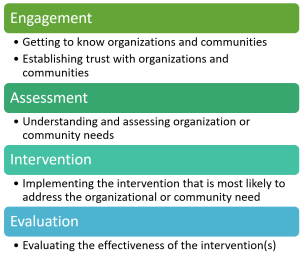9 Engagement is the Foundation
“You can say ‘all are welcome here’ but that is different from saying ‘this space was created for you in mind’”
Marnita Schroedl, CEO and Cofounder, Marnita’s Table[1]
 People are at the heart of community change since everything that is done is for the betterment of the people who live there. Engagement—in a very authentic way—is absolutely necessary. This is also the first step of any helping relationship—whether between a social worker and a client, a medical professional and a patient, a business owner and a customer, etc. —as shown in the following graphic depicting generalist skills.
People are at the heart of community change since everything that is done is for the betterment of the people who live there. Engagement—in a very authentic way—is absolutely necessary. This is also the first step of any helping relationship—whether between a social worker and a client, a medical professional and a patient, a business owner and a customer, etc. —as shown in the following graphic depicting generalist skills.
The generalist skills are just as relevant to macro practice as they are to working with individuals and families (micro practice), as described in the following graphic.

Identifying Community
Community can be used to describe the many ways that people are connected. This could be through place, experience, history, identity, etc. Before engaging in community change, it is necessary to identify the specific community you are referring to. Examples of communities include:
- Neighborhood
- Parent group
- City or town
- Identity group
- Apartment or housing location
- Group of people who share a common experience
Engaging in Proximity
Proximity to the community is critical. The closer you are to the actual people who are likely to benefit from your work, the more likely it is that the intervention will be desired and impactful. Engaging from a distance perpetuates distrust. Engaging with proximity fosters trust and relationships, which is foundational to community change work. Would you want a stranger to come into your home to tell you what needs to change in order to have a better living environment? Likely not.
Engaging to the extent that you need to will likely take a while so you need to be patient. Don’t force the engagement because there are often decades of reasons for suspicion and distrust. This is particularly the case if your organization represents an institution (including government, school, law enforcement, social welfare services, health care services, and others) in your community that has committed harm, whether to a specific community member or not. This leaves a legacy of distrust.
It is very important to have an open mind when you first engage with a community. Coming to a community with ideas already formulated or rushing to solutions before engagement will usually lead to failure at some point; you will likely lack buy-in from the community, and your ideas or interventions will be based on outside perceptions of what is needed and desired, not the specific ideas or needs as articulated by the community. Being open to new ideas and new perspectives will almost always lead to better outcomes, and likely solutions that you on your own would not have considered. That should excite you, not intimidate you.
So, again, practice patience and enjoy getting connected to the community. It is often the most enjoyable part of community change work. This section will cover three primary ways that we engage with others in our community as we embark on community change work:
- Identifying, inviting, and listening to stakeholders
- Engaging philanthropy as stakeholders
- Working in collaboration
- This is Civity. Episode 25. Marnita’s Table on Helping People in Communities SEE Each Other. September 29, 2020. ↵